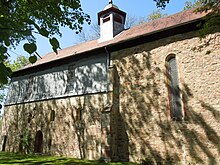Fraumünster Church Fritzlar
The Fraumünster Church stands a little east of the old town of Fritzlar and was first mentioned in 1260. It may have been part of a short-lived nunnery; this is indicated by the name and some documents from the early 14th century. However, this has not been proven and is rather doubted today.
investment
The little one, St. Church dedicated to Mary is a Gothic building with remains of Romanesque walls. The south wall of the rectangular nave contains largely preserved Carolingian - Conradine remains with arched windows and a walled-in Romanesque portal with gable lintel, but with changes from the 12th century and the late Gothic. The square choir was expanded in the 13th century and contains traces of a former ribbed vault as well as high Gothic frescoes from the 13th and early 14th centuries; they show the adoration of the three kings, the crucifixion of Christ with Mary and John, and Christ as judge of the world. The sacrament niche and the baptismal font date from the 14th century.
The church was badly destroyed in the Thirty Years War and was not restored until 1675. The Hessian coat of arms with an inscription for the restoration of the church in the choir above comes from this time. In 1676 the remaining stone building was increased by a half-timbered structure , with a hipped roof on both sides and a six-sided ridge turret with a pigtail roof . Around 1700 a gallery was built into the interior of the ship. The organ front from the late Renaissance from 1630 was brought here from the Fritzlar Minorite Church in 1830 ; today's organ itself was only installed in 1962/63. On the west wall is the grave slab of the knight Philipp von Wildungen († 1544). In the roof turret there is a small bell in tone g2, which is rung by hand at church services and events.
The first restoration was carried out in 1962/63 and a thorough renovation of the building between 1991 and 1996.
The entire church area is enclosed by a high wall from 1731 with baroque gate posts. In the churchyard is an approximately fußhoher Vogt rock next to a stone cross, which the court of the place here until the early 19th century, existing of 13 pawn Court identifies.
history
The church was first mentioned in a document in 1260, when it was under the patronage of the Counts of Ziegenhain . In 1340 they ceded the church to the Petersstift Fritzlar. In 1377 an atonement was made in her to end a long feud between the Lords of Dalwigk and the city of Fritzlar.
There were often disputes about the church, as it was in Kurmainzisch- Fritzlar territory, but had been the parish church of the village of Obermöllrich , which belongs to the Landgraviate of Hesse , since the 13th century and remained so after the Reformation in the Landgraviate in 1527, when Protestant preachers took over the administration of the parish and the landgrave took over the patronage . In 1528 Jost Runcke was a preacher here, and his sermons were eagerly attended by 300 to 400 Fritzlar citizens. In 1596 the church finally came to Obermöllrich, which in 1585 also became the seat of the pastor. Until 1900 it was the cemetery church of the community of Obermöllrich. Until the secularization of the Fritzlar Franciscan monastery and the acquisition of the former monastery church by the local Protestant community, the Fraumünster church was also the parish church of the Protestant citizens of Fritzlar.
literature
- Werner Ide: From Adorf to Zwesten: Local history paperback for the Fritzlar-Homberg district, A. Bernecker, Melsungen, 1972
- Fritzlar: Portrait of a historical city. Compiled by Annelise Janzig, ed. Magistrat der Stadt Fritzlar, Fritzlar, 1964
- Clemens Lohmann: Cathedral and imperial city Fritzlar: Guide through history and architecture. Ed. Magistrate of the City of Fritzlar, Fritzlar, 2005 ISBN 3-925665-03-X
Web links
- Information on the Fritzlar parish on the website of the Fritzlar-Homberg deanery
Coordinates: 51 ° 7 ′ 49.8 ″ N , 9 ° 17 ′ 23.9 ″ E

